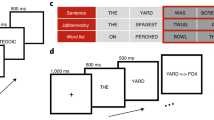Abstract
Visual half-field experiments have been used to investigate perceptual differences in reading different types of writing scripts. It has been observed that tachistoscopic recognition of phonetic-based scripts (such as the English alphabet and Japanese Kana) tends to show a right visual field–left hemisphere (RVF-LH) superiority effect1,2 whereas recognition of logographic symbols (for example, Chinese characters) tends to show a left visual field–right hemisphere (LVF-RH) superiority effect3,4. A cerebral orthography-specific localisation hypothesis has been proposed to account for these data. We have conducted three experiments to examine the visual lateralisation effect in reading logographic symbols such as Chinese characters. Chinese subjects in the first experiment were exposed to brief tachistoscopic presentation of a single character, and their task was to name the character as soon as possible. A LVF-RH superiority was found. In the second experiment, the stimuli were two vertically arranged characters and the subjects were asked to name the stimulus terms as soon as possible. The third experiment was the same as the second except that the task was to decide whether these character-strings were correct semantic terms with a manual response. A RVF-LH superiority effect was found in both the second and third experiments. These differential visual lateralisation results were interpreted as reflecting the function-specific property of the two hemispheres and cast doubt on the orthography-specific localisation hypothesis proposed by earlier investigators.
This is a preview of subscription content, access via your institution
Access options
Subscribe to this journal
Receive 51 print issues and online access
$199.00 per year
only $3.90 per issue
Buy this article
- Purchase on Springer Link
- Instant access to full article PDF
Prices may be subject to local taxes which are calculated during checkout
Similar content being viewed by others
References
Hardyck, C., Tzeng, O. J. L. & Wang, W. S-Y. Nature 269, 705–707 (1977).
Hirata, K. & Osaka, R. Psychologia 10, 7–18 (1967).
Hatta, T. Neuropsychologia 15, 685–688 (1977).
Sasanuma, S., Itoh, M., Mori, K. & Kobayashi, Y. Neuropsychologia 15, 547–553 (1977).
Sasanuma, S. Cortex 10, 89–97 (1974).
Wood, C. C., Goff, W. R. & Day, R. S. Science 173, 1248–1251 (1971).
Tzeng, O. J. L., Hung, D. L. & Wang, W. S-Y. J. exp. Psychol. Hum. Learning Memory 3, 621–630 (1977).
Wang, W. S-Y. Scientist Am. 228, 51–60 (1973).
Pavio, A. Imagery and Verbal Processes (Holt, Rinehart and Winston, New York, 1971).
Patternson, K. & Bradshaw, J. L. J. exp. Psychol. Hum. Perception Performance 1, 246–252 (1975).
Author information
Authors and Affiliations
Rights and permissions
About this article
Cite this article
Tzeng, O., Hung, D., Cotton, B. et al. Visual lateralisation effect in reading Chinese characters. Nature 282, 499–501 (1979). https://doi.org/10.1038/282499a0
Received:
Accepted:
Published:
Issue Date:
DOI: https://doi.org/10.1038/282499a0
This article is cited by
-
Does “a picture is worth 1000 words” apply to iconic Chinese words? Relationship of Chinese words and pictures
Scientific Reports (2018)
-
A Stroop effect emerges in the processing of complex Chinese characters that contain a color-related radical
Psychological Research (2015)
-
Centro-parietal N200: An event-related potential component specific to Chinese visual word recognition
Chinese Science Bulletin (2012)
-
How Sex, Native Language, and College Major Relate to the Cognitive Strategies Used during 3-D Mental Rotation
The Psychological Record (2008)
-
Orthographic effects for Chinese-English bilinguals in a picture-word interference task
Current Psychology (1988)
Comments
By submitting a comment you agree to abide by our Terms and Community Guidelines. If you find something abusive or that does not comply with our terms or guidelines please flag it as inappropriate.



